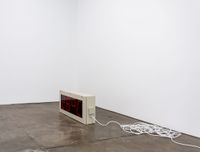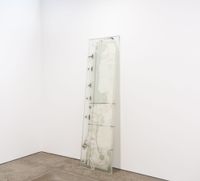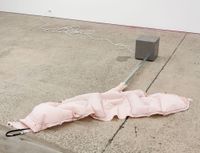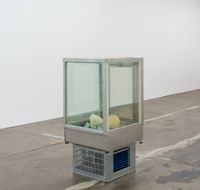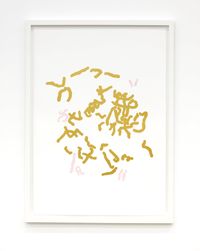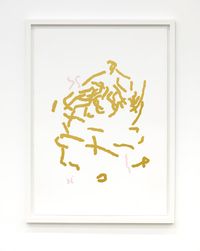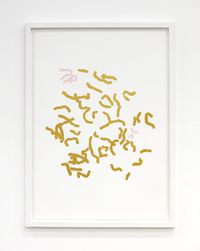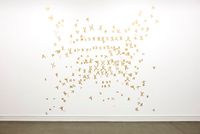New Zealand-born artist Alicia Frankovich works predominantly in performance and film, but also has been known to utilise mediums such as drawing, sculpture and photography. Through her work she grapples with the performativity of bodies, exploring the body's presence and identity within space and amongst other bodies.
Read MoreWhile at AUT University Frankovich studied sculpture, and there remains a strong relationship between the sculptural nature of Frankovich's performance work and the physicality of her sculptures. Her exhibition, The Female has Undergone Several Manifestations at Starkwhite, Auckland (6 February–5 March 2016), exemplified the non-performance side of this interdisciplinary relationship. Included in the exhibition were photographs, sculptures, prints and drawings that reflect on the physical and social body. In the exhibition, a pile of swimming goggles sat on top of a white non-slip drainage pool mat, while nearby a group of spiked hollow shells sat on and beside a blue version of the mat. The objects, surprisingly bodily in and of themselves, then take on the role of the absent figure. In this conversion, both the materiality of the body and the bodily nature of materials is emphasised.
When interviewed by Ocula Magazine in 2016, Frankovich expounded upon the importance of a conversation existing between her works, saying 'The sprawl of works allow for energy to spread throughout the room. Each work contains its own sense of time and then the dialogue between adds another one.' It is in statements such as this that Frankovich's approach of cumulative and relational meaning is revealed. In one large-scale photograph from The Female has Undergone Several Manifestations, orange peels are strewn across a dirty concrete ground. As with the sculptural objects of the same exhibition, the peels point to a physical life outside of the frame, but leave the viewer with only the remnants of such life. The sculptures and this photograph conceptually bounce off of each other, one telling a story of the city, the other of the sea, but both of absence as much as presence. By this mode Frankovich is able to reflect and build upon the layers of space and time in which the body's existence remains only as a trace.
While in her sculptural and two-dimensional work Frankovich explores the traces of the body in materials and materiality, in her performance practice she often considers the body's relationship to convention, and the restraint and release present in such a relationship. In both practices, she pushes the definitions and modes of a body. Her performative investigation has manifested itself in works such as Defending Plural Experiences (2014), commissioned by the Australian Centre for Contemporary Art for the exhibition Framed Movements (10 October–23 November 2014). For part of this piece, Frankovich cast a group of performers—both trained and untrained—and choreographed a performance with them in the butterfly enclosure of Melbourne's zoo. The performers completed a series of movements such as giving birth (a gender-neutral role in Frankovich's choreography) or pretending to be an animal, as well as more abstract gestures. In the film made from the performance recording, Frankovich includes shots of both the butterflies and the performers. Overlapping this footage is an avatar following its own set of choreography. In some manifestations, this avatar looks strikingly similar to the artist herself. In works such as Defending Plural Experiences, the viewer witnesses Frankovich's interest in transitional states—the body's movement from one form to another. In this, Frankovich allows the viewer to consider bodies beyond their physical givens, reaching out to deeper potentials of plurality.
Prior to Defending Plural Experiences, Frankovich examined a sense of plurality through shared social context with the work Free Time (2013). For this piece, Frankovich choreographed semi-spontaneous performances by a group of participants. These performances embodied a range of work and leisure activities, such as going for a jog or surfing the web on a laptop. Taken out of their natural habitats and into the gallery space, these activities became abstracted and open to re-interpretation. In such forms Frankovich remains dedicated to a deep-set and ongoing questioning of established 'norms'. Her subversion of the body's ingrained habits allows the viewer to open their mind to the performativity of all actions, including the movements of everyday life.
Casey Carsel | Ocula | 2017
